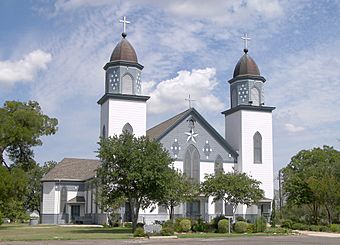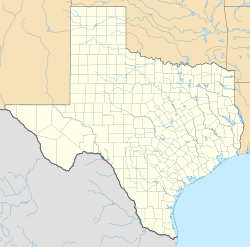Westphalia, Texas facts for kids
Quick facts for kids
Westphalia, Texas
|
|
|---|---|
| Country | |
| State | |
| County | |
| Elevation | 574 ft (175 m) |
| Population
(2000)
|
|
| • Total | 186 |
| Time zone | UTC-6 (Central (CST)) |
| • Summer (DST) | UTC-5 (CDT) |
| ZIP code |
76656
|
| Area code(s) | 254 |
Westphalia is a small community in Falls County, Texas, United States. It is not officially a city or town. Westphalia is about 35 miles south of Waco on State Highway 320.
This community has a strong German and Catholic history. The Church of the Visitation was once the largest wooden church west of the Mississippi River. Westphalia is famous for its historic church and convents. People also know it for its meat market and a big yearly church picnic. The "Westphalia Waltz" is a special dance linked to the area.
Students in the area attend schools in the Westphalia Independent School District.
Contents
- Discovering Westphalia's Historic Charm
- Historic Buildings and Farms in Westphalia
- The Church of the Visitation of the Blessed Virgin
- St. Mary's Cemetery
- Westphalia Little School
- Minnie Hoelscher House
- Dr. B.A. and Katie Jansing House
- Hoelscher/Thornton Store
- Stefka/Hoelscher/Doskocil Cotton Gin
- Christopher and Mary Fuchs Farmstead
- Anton Jansing Estate
- Elizabeth Biemer Farmstead
- Joseph and Clothilde Kahlig Farmstead
- G.P. Hoelscher Farmstead
- Henry Meyer Farmstead
- Frank J. and Julia Buckholt Farmstead
- Images for kids
Discovering Westphalia's Historic Charm
|
Westphalia Rural Historic District
|
|

Church of the Visitation in 2008
|
|
| Location | Roughly bounded by Co. Rt. 383, Pond Cr., Co. Rts. 377, 368, 372, 373, and the Falls Co. western boundary line, Westphalia, Texas |
|---|---|
| Area | 5,500 acres (2,200 ha) |
| Built | 1879 |
| Architectural style | Bungalow/Craftsman |
| NRHP reference No. | 96000524 |
| Added to NRHP | May 15, 1996 |
The entire community of Westphalia, along with a large area of 5,500 acres around it, is a special place. It is listed on the National Register of Historic Places (NRHP) as the Westphalia Rural Historic District. This means it is important for its history and culture.
The district is known for its German Catholic traditions. Westphalia has the main Catholic church for the area. It also has schools and businesses that served local farmers. Outside the town, there are 35 old farmsteads. These farms have buildings from the late 1800s and early 1900s. They still look much like they did back then.
Westphalia was never officially a city. It grew along three main streets. Church Road, now County Road 3000, had the Church of the Visitation. It also had the rectory (priest's house), parish hall, cemetery, schools, and a former convent. Main Village Road (CR 366 and CR 380) was the town's business center. This changed in 1938 when State Highway 320 was built. Cotton Gin Road (CR 366 south of CR 380) led to the cotton gin. This was the only industrial building in town.
The farms around Westphalia were set up in a grid pattern. They grew corn and cotton and raised livestock. The tall steeples of the Church of the Visitation can be seen from almost anywhere in the district. This shows how important the church was to the community.
Historic Buildings and Farms in Westphalia
The Westphalia Rural Historic District has many important old buildings and places. Here are some examples:
The Church of the Visitation of the Blessed Virgin
This church was built between 1894 and 1895. It was shaped like a Latin cross. The church had two tall 80-foot bell towers. These towers had copper domes and Maltese crosses, a German symbol. The church's design reminded people of the Westphalia region in Germany. This was where many of the town's first settlers came from. The church was sadly destroyed by a fire on July 29, 2019.
St. Mary's Cemetery
This cemetery was started around 1895. The first burial was in 1884. Most graves have gravel and are in family plots. The headstones face east toward the church. Many older headstones have German writing and Maltese crosses. In the center is a bronze statue of Jesus on the cross. It was brought from France in 1908.
Westphalia Little School
This school was built in 1896. It was a simple, three-room building. It looked like many farmhouses built at that time. The school had a special entry porch and fish-scale shingles. It was used as a school until 1989.
Minnie Hoelscher House
This house was built before 1890. It is the oldest known home in Westphalia. Minnie Hoelscher, a dressmaker, lived here. It was a small, two-room home, typical of farmhouses then. Minnie also welcomed boarders into her home. The property also had a barn, shed, and well.
Dr. B.A. and Katie Jansing House
This house was built in 1921. It is a one-story bungalow in the town's business area. Dr. Jansing was a very important doctor in Westphalia for a long time. The house shows Craftsman style. It has special geometric designs on the gables and simple columns.
Hoelscher/Thornton Store
Built in 1907, this is the oldest business building still standing in the historic district. It used to sell dry goods. The store still has its original look and design. Descendants of the first owners still run the business. It is a popular meeting spot for people in Westphalia.
Stefka/Hoelscher/Doskocil Cotton Gin
This cotton gin was built around 1930. It is on the edge of town, next to cotton fields. A cotton gin separates cotton fibers from their seeds. This gin is still working today. It helps the local farming community.
Christopher and Mary Fuchs Farmstead
Christopher and Mary Fuchs came from Germany. They bought this farm in 1890. The farmhouse is one of the oldest buildings in the district. The farm has more than a dozen other old buildings. This farm shows what a first-generation Westphalia farm looked like. It even has a rare area of prairie grass that has never been plowed.
Anton Jansing Estate
Anton Jansing was one of the first German Catholic settlers. He arrived in 1888 and helped start the church. His farmhouse, built around 1890, is still standing. It has a special front door with glass on the sides and top.
Elizabeth Biemer Farmstead
This farmstead, with a house built around 1915, is a good example of a "second-generation" farm. Elizabeth Biemer was a German immigrant. She ran the farm with her four children after her husband died. The house has a high, sloped roof.
Joseph and Clothilde Kahlig Farmstead
Joseph A. Kahlig got this property in 1884. He built the farmhouse around 1890. It is a good example of the old homes in the district. The farm has many outbuildings. These include a hay barn, animal barn, root cellar, and a working well.
G.P. Hoelscher Farmstead
This farmstead has 10 historic buildings and a garden. The G.P. Hoelscher House, built around 1890, is similar to other homes in the area. The yard has decorative metal gates and fences. It is planted with trees and flowers like roses and holly.
Henry Meyer Farmstead
Even though some parts of this property are old and worn, it still shows important historical traditions. The farmhouse, built around 1900, is unique in its design. It has a two-story house with a porch. The farm also has a well and several barns.
Frank J. and Julia Buckholt Farmstead
This farm was inherited by Frank Buckholt from his father. The house, built in 1912, is a "second-generation" home. Frank Buckholt was raised here. He later became the organist at the Catholic church for 52 years. The house is a mix of Craftsman and Victorian styles. The farm also has a hay barn, chicken houses, and a garage.
Images for kids





